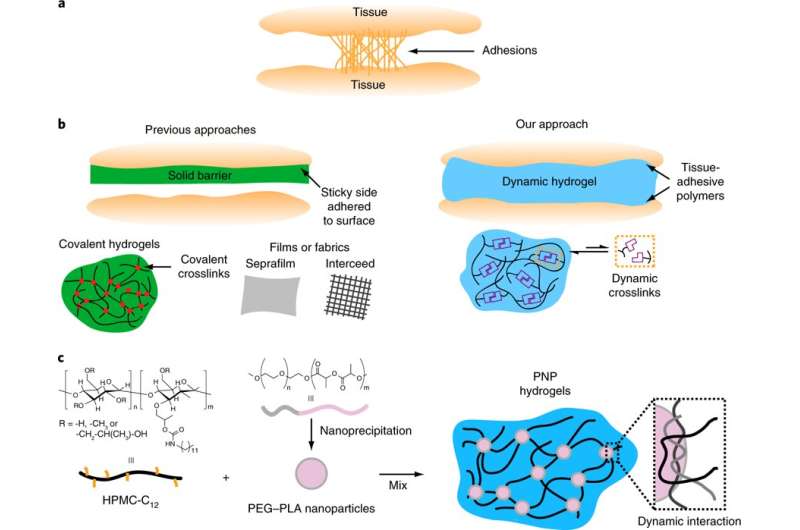Researchers discover gel reduces scar tissue after surgery in animals

Researchers at Stanford University have found that spraying a gel on the internal tissues of animals after cardiac surgery greatly reduces adhesions, fibrous bands that form between internal organs and tissues. Adhesions can cause serious, even fatal, complications.
The gel, developed at Stanford to deliver medications, was far more effective than adhesion prevention materials currently on the market, the researchers said. It appeared to be safe in the animal study.
"The difference between what we saw after using the gel and what we normally see after surgery was drastic," said Joseph Woo, MD, professor and chair of cardiothoracic surgery and the Norman E. Shumway Professor.
A paper describing the research published August 7 in Nature Biomedical Engineering. Woo and Eric Appel, Ph.D., an assistant professor of materials science and engineering, are the senior authors. Lyndsay Stapleton, a graduate student in bioengineering, is the lead author.
Adhesions form after 95% of surgeries. Some are harmless, but after abdominal surgeries, they can twist or compress the intestines, causing life-threatening blockages. Gynecological surgery can also lead to adhesions that cause infertility. In cardiac re-operations, common for those born with heart defects, adhesions increase the risk of complications.
Previous methods, lot of failures
Methods to prevent adhesions—including animal membranes, sheets of rubber and mineral oil—have existed for more 100 years, but they have mostly failed. Current adhesion barriers approved by the Food and Drug Administration are rarely used; they are difficult to deploy and are considered ineffective.
The Stanford researchers had long pondered a solution to the adhesion problem. But one day, when Stapleton was working with lab rats to develop an injectable therapy to reduce tissue damage following a heart attack, Appel suggested she try spraying a polymer-nanoparticle hydrogel onto the hearts and surrounding tissue after surgery to see if it reduced the formation of adhesions. Weeks later, when she operated on the animals again, she saw that no adhesions had formed.
"It was pretty striking," she said. "I thought, 'Oh wow, we could be onto something here.'"
The researchers decided to conduct a study. First, they formulated four additional gels with a range of properties. Then, after inducing heart attacks in rats, they randomly divided the animals into eight treatment groups: five that each received a different gel, two that received commercially available adhesion barriers and one that received no treatment.
Four weeks later, the rats that had received no treatment or either of the two commercial adhesion barriers had formed dense adhesions: Their hearts were connected to their chest walls. The rats that were treated with two of the five gels had formed moderate to dense adhesions. The rats treated with the other three gels fared much better, with very few adhesions. PNP 1:10, the gel Stapleton initially tried, completely prevented adhesions.
The researchers then tested PNP 1:10 in sheep, whose hearts are similar in size and shape to human hearts; they found similar results.
Like mayonnaise
PNP 1:10 was stiff enough to stick, but not so stiff it detached from the organs, Appel said. "It was sort of a Goldilocks sweet spot." He compared PNP 1:10 to mayonnaise: thick, but easily spreadable. That property allows it to be sprayed onto an organ but then immediately reform its original strength.
The gel also has the ideal tension between stickiness and slipperiness: "It covers all of the irregular surfaces of the heart, adhering to the tissues, but not to itself," Woo said.
And it's flexible, allowing the heart to beat: "The gel doesn't prevent tissues from moving around," Appel said. "It simply provides a physical barrier to keep them from sticking to each other."
PNP 1:10 dissolves and is absorbed by the body about two weeks after its application—enough time for healing to occur, Appel said. PNP 1:10 is not approved for use in patients, but it is made of components that the Food and Drug Administration has approved. As part of the study, the researchers tested the rats to see if they showed any reaction to the gel; they saw no abnormalities in the surrounding tissues or in the blood.
The researchers next plan to try PNP 1:10 in abdominal surgery in rats. They hope to conduct human trials soon.
More information: Lyndsay M. Stapleton et al. Use of a supramolecular polymeric hydrogel as an effective post-operative pericardial adhesion barrier, Nature Biomedical Engineering (2019). DOI: 10.1038/s41551-019-0442-z
Journal information: Nature Biomedical Engineering
Provided by Stanford University Medical Center

















